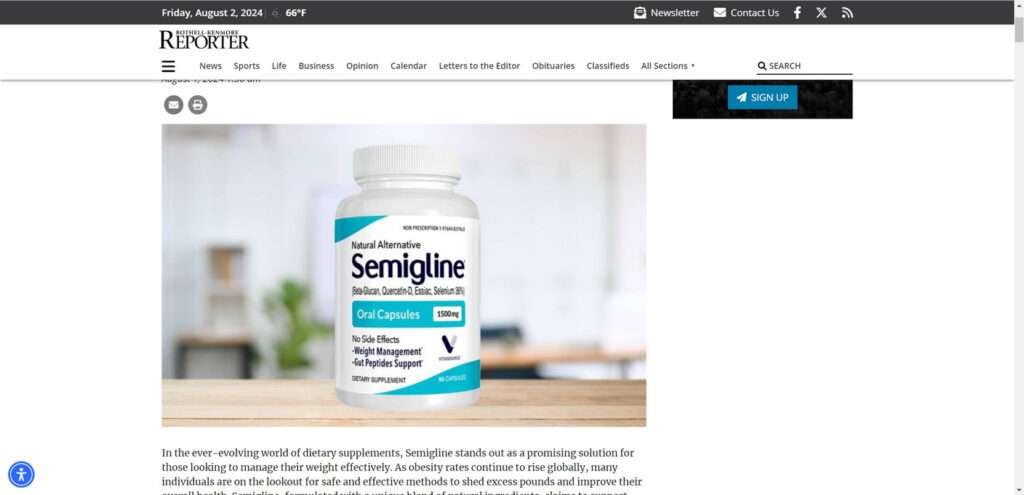Losing weight can be an incredibly difficult journey. With enticing promotions for “miracle” pills and potions promising dramatic slimming with little effort, it’s easy to fall victim to scams and false hopes.
One such product making bold claims is Semigline – a supplement marketed as a natural weight loss solution that “comprises a carefully selected blend of natural ingredients” to promote fat burning. But does the science support these assertions? Or is Semigline simply preying on the vulnerabilities of those struggling to lose weight?
In this extensive exposé, we’ll scrutinize Semigline’s formulation, advertised benefits, potential dangers, suspicious practices, misleading marketing and more to uncover the inconvenient truths and empower you to make an informed decision.

Analysing Semigline’s Formula
Semigline touts a proprietary blend of herbs, plant extracts, vitamins and minerals. While natural ingredients can certainly provide health advantages, the key is whether adequate clinical evidence supports their benefits – especially for weight loss. Let’s examine some of the primary active ingredients:
Soursop Leaf
Soursop shows potential as an antioxidant and anti-inflammatory. But current research has not confirmed significant effects for weight loss in humans. There is insufficient evidence soursop leaf balances gut peptides or appetite as claimed.
Raspberry Fruit
Raspberries offer antioxidants, vitamins and fiber. But studies do not validate raspberry ketones for fat burning in humans. Any appetite or weight loss benefits are likely minor at best.
Beta Glucan
Derived from oats and barley, beta glucan is a soluble fiber which may help regulate cholesterol and blood sugar. However, evidence does not confirm it produces meaningful weight loss. Amounts in Semigline are probably insignificant.
Turmeric
Curcumin in turmeric has antioxidant and anti-inflammatory activities. But human data is lacking on turmeric significantly impacting weight management. Effects are likely insignificant at doses in supplements.
Grape Seed Extract
Grape seed provides antioxidant OPCs that benefit circulation. But there’s no proof these compounds meaningfully promote weight loss in humans. Effects are doubtful at small doses.
Green Tea Extract
Of all the ingredients, only green tea shows potential to mildly boost fat burning and metabolism. However, optimal doses for weight loss are much higher than what is likely found in Semigline.
Overall, Semigline’s formula lacks scientific substantiation for producing dramatic slimming effects. A few components may provide mild health advantages but evidence supporting weight loss claims is severely lacking.
Deceptive Marketing Tactics
Beyond unfounded ingredient claims, Semigline exhibits several misleading strategies commonly used to deceive consumers, including:
- Before and after photos of improbable transformations, likely using stock images.
- Fabricated testimonials with unbelievable claims unsupported by proof.
- Promise of substantial weight loss without diet or exercise – an unrealistic notion.
- Exaggerated assertions of “balancing gut peptides” and correcting “hormonal imbalances”, unproven in humans.
- Misrepresentation of research – studies cited don’t confirm advertised benefits.
- illusion of scarcity to create false urgency – “limited time offer!”
Such deceptive tactics render Semigline’s credibility highly suspect and signal it is primarily a money-making scheme, not an effective solution.
Real Customer Reviews Reveal The Truth
Looking past the company’s own propaganda to impartial sources exposes the stark reality behind Semigline. Numerous reviews from actual customers report:
- No noticeable weight loss benefits even after months of use.
- Adverse side effects like headaches, diarrhea, nausea.
- Difficulty reaching customer service, lack of responsiveness.
- Unauthorized charges to credit cards for undisclosed auto-ship programs.
- Refusal to issue refunds for unsatisfied customers.
These concerning experiences reveal Semigline does not deliver on its lofty weight loss claims and uses unscrupulous business practices – extraction of money seems to be the top priority, not customer health.
The Potential Dangers of Semigline
While advertised as completely safe, Semigline is not free of risks. As an unproven product lacking human trials, its safety is uncertain. Ingredients like garcinia cambogia and green tea extract can potentially cause side effects in some individuals. Those with medical conditions or on medication should exercise extreme caution with Semigline’s unvalidated formulation.
Of particular concern are the numerous artificial fillers and binders within Semigline, which can trigger allergic reactions. There is also no transparency regarding manufacturing quality control. With countless cases of supplements containing unlisted contaminants, Semigline’s purity is questionable at best. Putting your health in the hands of an untrustworthy company peddling a scientifically unsubstantiated formula constitutes a real risk.
The Verdict: Should You Buy Semigline?
When a supplement brand relies on hype rather than evidence, exploits deceptive marketing and loses customer trust, any benefit claims should be viewed with utmost skepticism.
Considering its unproven formula, misleading promotional tactics, safety concerns, negative reviews and lack of efficacy, Semigline fails to demonstrate it is a high quality, effective solution for weight management. At best, it may provide a negligible placebo effect rather than meaningful results.
While the creators of Semigline may profit handsomely from sales built on empty promises, those who suffer are the masses of consumers left disappointed, exploited and potentially harmed.
The possibility of minor appetite suppression or metabolism support cannot justify the potential wasted money and health risks. Don’t gamble your wellbeing on a substandard product – you deserve better. Seek sustainable, holistic options backed by science to achieve your health and weight loss goals, not shortcuts peddled by companies leveraging your vulnerabilities. With knowledge, we can see past the hype and make empowered choices. Your health is too important to put at risk. You’ve got this!










